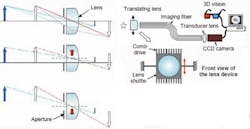3-D images created by movement of single lens
Researchers at the University of California, Los Angeles (UCLA; Los Angeles, CA, USA) and Intelligent Optical Systems (IOS; Torrance, CA, USA) have developed a novel 3-D imaging system built around a moveable single lens.
Many stereo imaging systems make use of a pair of cameras to view objects of interest, which inevitably increases overall size and structural complexity of the system compared to single imaging systems.
The new system however, makes use of a single moving lens to create stereo images. The principle of operation is elegant, yet straightforward. When the lens center is on the optical axis, images of two objects in the field of view of the system have their bases on the optical axis. When the lens moves upward or downward, the images of the objects behind the lens move up or down.
However, because the images of the closer objects shift more than those of farther objects when the lens moves, the relationship between the distance the object is from the lens and the amount the image is shifted can be used to reconstruct a 3-D image of the objects in a scene.
To test out the idea, the researchers built a stereo imaging device consisting of a lens driven by two sets of electrostatic comb actuators, a fiber-optic bundle, a transducer lens, and a CCD camera connected to a computer. The computer captures the images shifted at the extreme lens locations and separates the images into two real-time streams for 3-D viewing.
The researchers say that their next task will be to integrate a smaller version of the system with an endoscope less than 1 cm in diameter that could be used to inspect confined and hard-to-reach spaces.
They described the design of the system at the MEMS 2012 conference in Paris, France earlier in the year. A complete technical paper describing the work can be found here.
-- Dave Wilson, Senior Editor, Vision Systems Design
